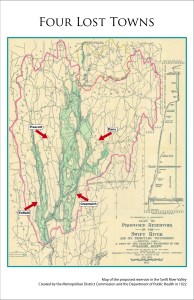In the late 19th century, the city of Boston, like most of New England’s other cities, experienced a period of incredible growth thanks to increasing industrialization and a rising tide of European immigration. By the early 20th century, Boston city officials realized they were only a few decades away from a full-blown crisis if they could not secure a much larger supply of fresh water for the city’s increasing population.

In response, civil engineers drafted a plan to create a massive reservoir in central Massachusetts to ensure a steady supply of water for the greater Boston area. The plan was met with intense opposition from the moment it was announced, both from residents of the four rural towns that would be displaced by the reservoir, and from Connecticut state officials who were deeply concerned about the plan to fill the reservoir with water siphoned from the Connecticut River watershed. In December of 1927, after Massachusetts officials had applied to the United States War Department to request a permit to divert water from the Connecticut River to the proposed new reservoir, Connecticut state attorneys sprang into action, instigating a formal legal complaint against their neighbor to the north that became known as Connecticut v. Massachusetts, a legal case that eventually worked its way up to the United States Supreme Court.
In Connecticut v. Massachusetts, the defendants claimed that “An emergency exists in Boston…and unless water is supplied in the metropolitan area a grave and serious danger exists.” In reply, Connecticut argued that a diversion of waters would seriously harm the many commerce, transportation, and recreation activities in the state that depended on the Connecticut River. In the face of escalating legal tensions, the Secretary of War, Dwight Davis, announced on March 15, 1928 that the War Department would neither oppose nor grant Massachusetts its desired water permit, and instead wait on the decision of the Supreme Court before proceeding further. Several months later, in January 1929, the Supreme Court sided with Massachusetts after the Bay State agreed to abide to a strict set of limits upon the amount of water it could divert from the Connecticut River watershed.
In 1939, after years of construction and clearing out the land once occupied by four rural towns, water diverted from the Connecticut River watershed first started flowing into what is now the Quabbin Reservoir in central Massachusetts. The Quabbin Reservoir, with a capacity of 412 billion gallons, remains one of the largest man-made freshwater reservoirs in the world and, thanks to the efforts of quick-thinking Connecticut officials in the 1920s, the Connecticut River is none the worse for wear. Water enough for all, on this day in Connecticut history.

Further Reading
“Historical Note: Connecticut vs. Massachusetts, 1890-1932,” Connecticut State Library
“Quabbin Park and Reservoir,” Massachusetts Department of Conservation and Recreation [pdf]

